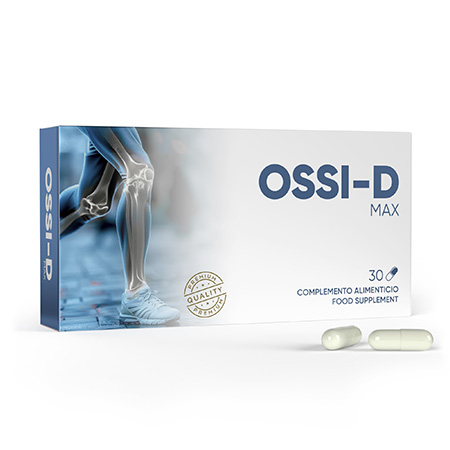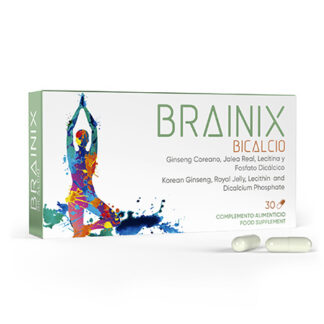Description
Ossi-D MAX is formulated with mineral ingredients and vitamin D3 that help preserve bone integrity and density.
The formulation of Ossi-D MAX contributes to optimise the absorption of ingredients thanks to its enteric coating technology and protects the capsule from stomach acids, enabling its content to be released and absorbed in the intestine.
The formula of Ossi-D MAX contains a selection of minerals: Calcium, Magnesium, Zinc, Iron, Copper, Manganese, Selenium and vitamin D3 in an exclusive extended-release capsule (ER formulation) which provides the following properties (EFSA):
- Calcium, Magnesium, Zinc, Manganese and Vitamin D contribute to normal bone maintenance.
- Calcium is necessary for the maintenance of teeth, and Zinc and vitamin D contribute to normal maintenance of teeth.
- Vitamin D contributes to normal absorption and utilisation of calcium and phosphorus, in addition to normal blood calcium levels.
- Vitamin K2 is Menaquinone-7, which has got an effective bioavailability and the longest half-life (Kanellakis, 2012).
- Magnesium and Zinc participate in the process of cell division, as well as Calcium, which also participates in cell differentiation.
- Iron contributes to normal synthesis of red blood cells and haemoglobin, the oxygen transport within the body and to normal cognitive function in the development of children (EFSA).
- Copper and Manganese contribute to normal formation of connective tissue.
- Zinc contributes to acid-base metabolism, while Magnesium contributes to electrolyte balance.
- Calcium, Copper and Manganese contribute to normal energy-yielding metabolism.
- Zinc, Copper and Selenium contribute to cell protection from oxidative damage.
Ossi-D MAX is a food supplement for adults who want to maintain and help their bone mass, and for athletes who are concerned about their bone structure.
 BONE QUALITY |  VITAMIN D3 |  MINERALS |
INGREDIENTS
Calcium carbonate, magnesium oxide, zinc gluconate, bulking agent (microcrystalline cellulose), ferrous bisglycinate, vitamin K2 (7-menaquinone), vitamin D3 (cholecalciferol), anti-caking agents (silicon dioxide, magnesium stearate), manganese gluconate dihydrate, copper (II) sulphate, and sodium selenite.
Vegetable capsule composition: hypromellose.
| ACTIVE INGREDIENTS | PER CAPSULE | %NRV |
| Calcium | 800 mg | 100 |
| Magnesium | 300 mg | 80 |
| Iron | 14 mg | 100 |
| Zinc | 10 mg | 100 |
| Copper | 1 mg | 100 |
| Manganese | 0.5 mg | 25 |
| Vitamin K2 | 80 μg | 107 |
| Selenium | 50 μg | 91 |
| Vitamin D3 | 30 μg | 300 |
| %NRV (nutrient reference value) | ||
ADDITIONAL INFORMATION
EAN: 8410885095886
· It is recommended to keep a varied and balanced diet and healthy lifestyle.
· Do not exceed the recommended daily dose.
· Keep away from children.
· Do not store at a temperatures above 30ºC.
TO KNOW MORE
Bones and their minerals
Bones are firm, hard and resistant organs that are part of the skeleton, which mainly comprises a specialised type of connective tissue made up of three elements: cells, organic and inorganic matrix.
- Bone cells are made up of three types of specialised cells: osteoblasts, osteocytes and osteoclasts. These cells are responsible for bone growth and mineral balance.
- The organic matrix occupies 30% and is mainly made up of collagen (90%) whose fibres give the bone resistance to traction forces.
- The inorganic matrix occupies 70% of bones and consists of mineral deposits in the form of hydroxyapatite which are like crystals favouring mineralisation. These hydroxyapatite crystals, mainly formed by tricalcium phosphate, calcium carbonate, magnesium and other minerals, modify the physical properties, forming an important framework between the collagen fibres, what gives rise to exceptional mechanical qualities. These mineralised crystals are responsible for the resistance of bones to compression forces.
Among the functions of bones is the storage of minerals for the body. This is a dynamic process activated when the bone grows, undergoes remodeling or when the body needs a specific mineral.
Throughout life changes in bone mass known as modeling (growth and development) and remodeling (metabolic balance) occur. The highest point of bone mineralisation is obtained in the third decade of life, from which a progressive loss begins. The maintenance of bone function requires a correct integration between bone quality and density, involving the harmonisation of the structure, remodeling, accumulation of injuries and mineralisation of bones.
What are minerals and which ones are important for bones?
Minerals are nothing more than chemical elements that are indispensable for the chemical and electrical processes maintaining our body, and it is also important that they are found in balanced concentrations.
The most important minerals bones consist of are:
- Calcium: the body of an average adult contains about 1250g of calcium. More than 99% of calcium is found in bones and teeth. The best food sources of Calcium are: cow’s milk, which is a very rich source of calcium. One litre of cow’s milk contains 1200mg; dairy products, such as cheese and yoghurt, and small sea and river fish like sardines and herrings.
- Magnesium: adults contain 25g of this mineral in their body, 35% is found in muscles and soft tissues, and the remaining 65% in bone tissue. Most green vegetables, legume seeds, peas, beans and nuts are rich in magnesium, as well as some shellfish, spices and soya bean flour, all of which generally contain over 500 mg/kg of fresh weight.
- Zinc: a healthy adult body contains 2 to 3g of zinc and needs about 15mg of dietary zinc per day, which is stored in bones. Zinc is found in most foods of plant and animal origin, but the richest sources tend to be high-protein foods, such as meat, seafood, eggs, legumes and whole grains.
- Manganese: about 10g are stored inside the body, mainly in the kidneys, liver and bones. Manganese is mainly found in dried fruits, whole grains, sunflower and sesame seeds, egg yolk, legumes and green leafy vegetables.
What is vitamin K and how many types are there?
The first evidence regarding the existence of vitamin K occurred in 1929 while Henrik Dam was investigating diets free of sterols in chickens that developed internal bleeding and blood drawn from chickens slowly coagulated. In 1935, Dam proposed that the healing factor present in plant and animal sources was a new fat-soluble vitamin he called vitamin K. In 1939, Doisy’s group isolated an active compound named vitamin K1 from alfalfa and another, vitamin K2, from rotten fishmeal.
Vitamin K is a fat-soluble vitamin and counts on three types K1 (phylloquinone, produced by plant extracts), K2 (menaquinone, produced by bacteria) and K3 (menadione, origin of plant pigments, fungi and animals). Vitamin K2 is a product from bacterial fermentation and has got different variants called MQ-n. MQ-7 is the most bioavailable type with the longest half-life.
The highest concentrations of vitamin K are found in green leafy vegetables like cabbage, broccoli, Brussels sprouts and spinach. Animal products (meat, fish, dairy products and eggs) contain significant amounts, mainly from liver. Some vegetable oils, including canola (rapeseed), soya bean and olive oils, are rich sources of vitamin K.
What is vitamin D and how many types are there?
It was discovered in 1922 by the biochemical group led by Dr. Elmer McCollum. They found that cod liver oil retained its antirachitic properties even when vitamin A was destroyed, that is, cod liver oil contained a new fat-soluble vitamin, which McCollum named ‘fat-soluble vitamin D‘.
Vitamin D refers to a family of structurally related compounds showing antirachitic activity. Its structure is steroid-like and very similar to cholesterol. Vitamin D is represented by cholecalciferol (vitamin D3) and ergocalciferol (vitamin D2), which are structurally similar steroids derived from the provitamin D sterols. The difference is that vitamin D3 is produced by solar action on animal skin, while D2 is produced in plants, fungi and yeasts due to solar irradiation as well.
When ingested, both the D3 and D2 types are processed by the same metabolic pathway to become the active form of vitamin D (1α, 25-dihydroxyvitamin D). Recent findings show that vitamin D2 in humans has got only 25-30% of the biological activity of vitamin D3.
Natural sources of vitamin D come, first, from solar action, and then from fish liver oils, especially halibut liver oil, herring, sardines, and tuna. Smaller amounts of this vitamin are found in liver, eggs, and dairy products from mammals. Cereals, vegetables and fruits contain no vitamin D, while meat, poultry and white fish provide negligible amounts.

